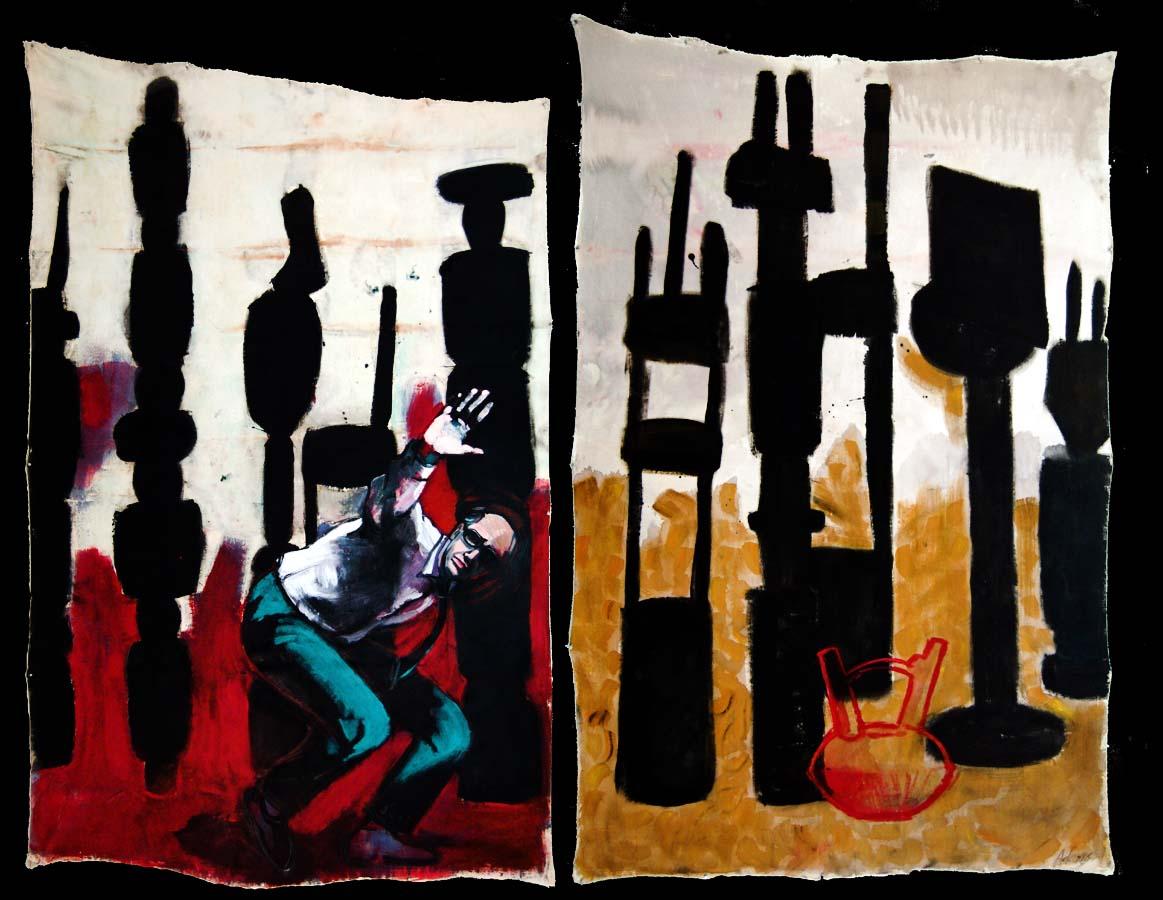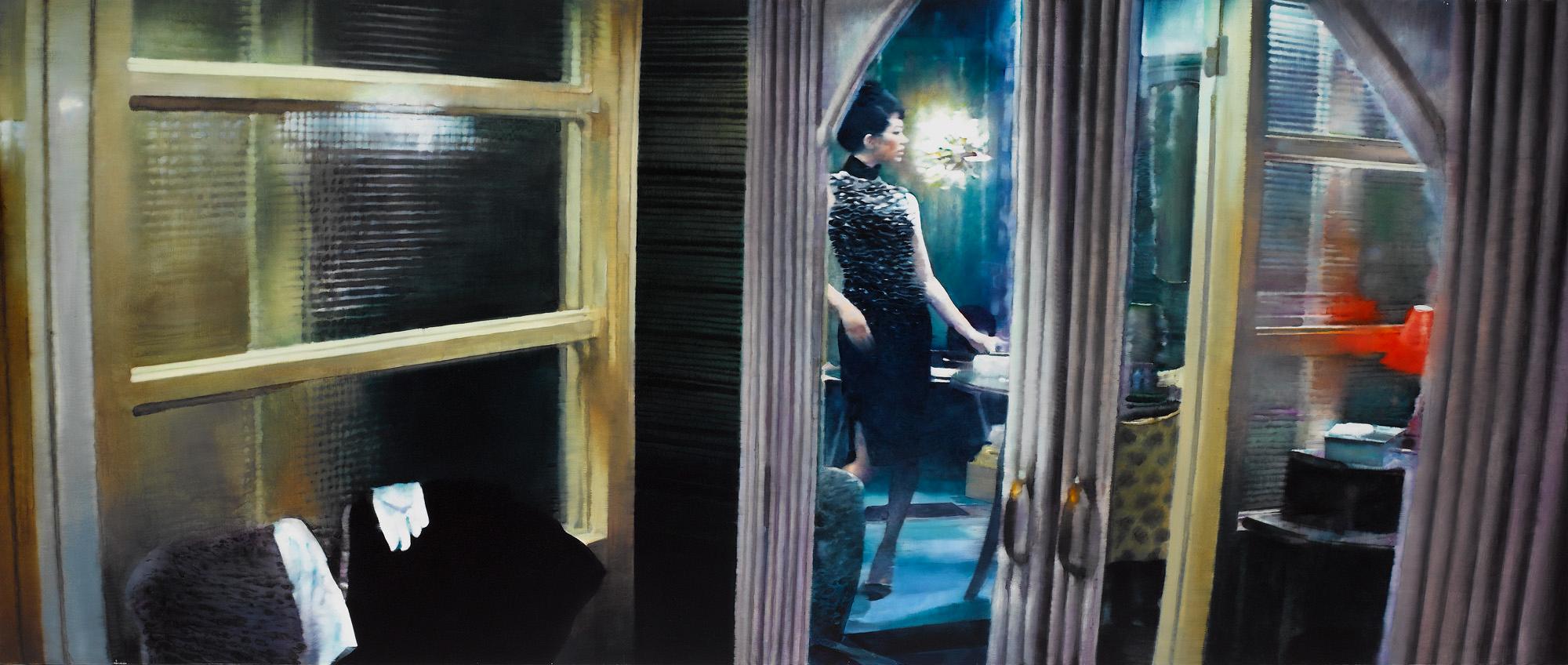Items Similar to The Musician
Want more images or videos?
Request additional images or videos from the seller
1 of 6
The Musician
About the Item
This head and shoulders portrait is an outstanding example of the breadth, force and beauty of this artist's pictorial manner and abilities. This captivating portrait features a musician holding his recorder, dressed in a dark robe and feathered cap. The recorder appears to be a five-hole Alto Recorder in F-sharp, a popular choice with musicians around the middle of the 18th century.
The man appears to have been playing this instrument just moments before but now has removed it from his lips. One could interpret this position as the man taking a breath between musical bars. However, given the distance between the recorder and the subject's mouth, as well as the wide-eyed gaze that he casts to his left, it is more likely that the sitter has been unexpectedly interrupted.
This dark-shadowed flute player with a brightly lit face acts as a wonderful example of the use of Chiaroscuro. Chiaroscuro, an Italian term which literally means 'light-dark', refers to the dramatic tonal shifts, as seen in this painting, that suggests the modelling and volume of subjects depicted. Here the subtle tonal grading of the body and dress give the figure materiality and three-dimensionality.
Henderick ter Brugghen
(1588 - 1629)
Ter Brugghen was, with Honthorst and Baburen, one of the main Dutch followers of the Italian artist Caravaggio. His family settled in Utrecht, probably in about 1591, where he was a pupil of Abraham Bloemaert. He travelled to Rome in about 1604, within the lifetime of Caravaggio, and remained there until 1614. By 1615 he had returned to Utrecht, where he died in 1629.
Ter Brugghen was the first important painter influenced by Caravaggio to return to Holland. He developed a highly personal style characterised by a soft handling of paint and pale vibrant colouring. He sometimes painted dark figures against a light background, which may have influenced such painters as Vermeer and Fabritius.
His subject matter covered religious, mythological and literary themes, together with representations of picturesque figures, often in domestic settings. His first dated painting is of 1620.
- Dimensions:Height: 25.25 in (64.14 cm)Width: 19.5 in (49.53 cm)
- More Editions & Sizes:1 of 1Price: $14,601
- Medium:
- Circle Of:Hendrick ter Brugghen (1588 - 1629, Dutch)
- Period:Late 17th Century
- Framing:Framing Options Available
- Condition:
- Gallery Location:London, GB
- Reference Number:1stDibs: LU52412176132
About the Seller
5.0
Vetted Seller
These experienced sellers undergo a comprehensive evaluation by our team of in-house experts.
Established in 2007
1stDibs seller since 2014
64 sales on 1stDibs
Typical response time: 3 hours
- ShippingRetrieving quote...Ships From: London, United Kingdom
- Return PolicyA return for this item may be initiated within 14 days of delivery.
More From This SellerView All
- Portrait of a GentlemanLocated in London, GBOil on canvas Image size: 17 x 23 1/2 inches (43 x 60 cm) Contemporary William Kent hand made frameCategory
18th Century Portrait Paintings
MaterialsCanvas, Oil
- Portrait of Herbert Fisher, Mid-19th Century Oil Painting, Original Watts FrameBy George Frederic WattsLocated in London, GBOil on canvas c.1855 - 1860 Image size: 19 x 14 inches (48.25 x 37.25 cm) Original Watts frame The Sitter Herbert William Fisher (1826 - 1903) was a British historian, best known for his 'Considerations on the Origin of the American War' (1865). Fisher was tutor to the future King Edward VII, and served as Private Secretary to the 5th Duke of Newcastle. in 1863 he became Private Secretary to the Prince of Wales, his former pupil, before being appointed to the position of Vice-Warden of the Stannaries in 1870. One of his daughters, Adeline, married Ralph Vaughan Williams. George Frederick Watts Watts (1817 - 1904) was a British painter and sculptor associated with the Symbolist movement. He is known to have said 'I paint ideas, not things'. Watts became famous in his lifetime for his allegorical works, such as 'Hope' and 'Love and Life' in which the emotions and aspiration life were intended to be represented in a universal symbolic language. Watts was born in Marylebone in central London on the birthday of George Frederic Handel (after whom he was named), to the second wife of a poor piano-maker. He showed artistic promise very early, learning sculpture from the age of 10 with William Behnes, starting to study devotedly the Elgin Marbles (later writing "It was from them alone that I learned") and then enrolling as a student at the Royal Academy Schools at the age of 18. He first exhibited at the Academy in 1837, with a picture of "The Wounded Heron" and two portraits, but his attendance at the Academy was short-lived, and his further art education was confined to personal experiment and endeavour, guided by a constant appeal to the standard of ancient Greek sculpture. He also began his portraiture career, receiving patronage from his close contemporary Alexander Constantine Ionides, who later came to be a close friend. In 1849 the first two of the allegorical compositions which form the most characteristic of the artist's productions were exhibited—"Life's Illusions," an elaborate presentment of the vanity of human desires, and "The people that sat in darkness," turning eagerly towards the growing dawn. In 1850 he first gave public expression to his intense longing to improve the condition of humanity in the picture of "The Good Samaritan" bending over the wounded traveller; this, as recorded in the catalogue of the Royal Academy, was "painted as an expression of the artist's admiration and respect for the noble philanthropy of Thomas Wright, of Manchester," and to that city he presented the work. From the late 1840s onward he painted many portraits in France and England, some of which are described below. Notable pictures of the same period are “Sir Galahad...Category
1850s Victorian Portrait Paintings
MaterialsCanvas, Oil
- Portrait of Thomas Cooper Gotch, 19th Century Oil PaintingLocated in London, GBOil on canvas on board Image size: 7 x 5¼ inches (18 x 13.5 cm) Framed This portrait of Thomas Gotch is by his lifelong friend and confidante, Jane Ross, whom he met at Heatherley’s...Category
1880s English School Portrait Paintings
MaterialsCanvas, Oil
- Portrait of a Lady, 17th Century Flemish Oil Old MastersBy Jacob HuysmansLocated in London, GBJacob Huysmans Flemish 1633 - 1696 Portrait of a Lady Oil on canvas Image size: 49 x 40 ¼ inches Gilt frame Huysmans was born in Antwerp and came to England during the reign of Charles II where he became one of the fashionable painters of the court.. The diarist Samual Pepys noted the artist as capable of a more exact likeness than Lely. Certainly the diarist records that by August 1664 in the circle of Queen Catherine...Category
17th Century Old Masters Portrait Paintings
MaterialsCanvas, Oil, Acrylic
- Portrait of Conrad Friedrich Hurlebusch, Early 18th Century Oil PaintingBy Dominicus van der SmissenLocated in London, GBDominicus van der Smissen Early 18th Century Portrait of Conrad Friedrich Hurlebusch Oil on canvas Image size: 20½ x 16¼ inches Period gilt frame This is a portrait of Conrad Friedrich Hurlebusch, composer, Kapellmeister and organist, whom Van der Smissen most probably portrayed during his stay in Hamburg, Brunswick or Amsterdam. The identification is based on the reproduction of the portrait which was engraved by Pieter Anthony Wakkerdak (1740- 1774). Van der Smissen has reduced the face of the sitters to an egg-shaped oval in three-quarter view, applying diminution to one half of the figure’s torso, which is farther away from the viewer. This partial side view, with the head turned to look at the viewer over the shoulder, creates spatial depth and brings the figure to life by avoiding the stiffness of a frontal depiction. Because the artist chose to highlight the figure from above, a distinct shadow is cast under the tip of the nose, in the shape of a triangle. This is an often recurring and almost ‘signature’-like feature in Van der Smissen’s oeuvre. Hurlebusch's garments are of a very high quality and serve to reflect the sitter’s wealth, status and elegance. During this period, gentlemen often shaved their heads in order to facilitate the wearing of a wig, which wouldbe worn with a suit. Here Hurlebusch has been depicted in a luxurious turban-like cap lined with lynx fur, a highly fashionable and expensive material at the time. Over his shirt, he wears a velvet fur-lined gown adorned with decorative clasps fashioned from silver braid. The elegant informality of his appearance can be seen in his unbuttoned shirt and the unfastened black ribbon hanging from his button hole, which has been artfully arranged into a fluttering drape by the portraitist. The Sitter Hurlebusch was born in Brunswick, Germany. He received the first instructions in his field from his father Heinrich Lorenz Hurlebusch, who was also a musician. As an organ virtuoso, he toured Europe, visiting Vienna, Munich and Italy. From 1723 to 1725 he was Kapellmeister in Stockholm; later he became Kapellmeister in Bayreuth and Brunswick, and lived in Hamburg from 1727 to 1742, where he had contact with fellow composers Johann Mattheson and Georg Philipp Telemann. He made his living composing, performing and teaching. In 1735 and 1736, he is believed to have visited Johann Sebastian Bach in Leipzig, who promoted Hurlebusch’s compositions as the local seller...Category
Early 18th Century Old Masters Portrait Paintings
MaterialsCanvas, Oil
- Portrait of William Ewart GladstoneLocated in London, GBOil on canvas Image size: 10 x 30 1/4 inches (25.5 x 77 cm) Original gilt Watts frame This is a head and shoulders portrait of William Ewart Gladstone painted after a photograph tak...Category
19th Century Naturalistic Portrait Paintings
MaterialsCanvas, Oil
You May Also Like
- Island of Broken Toys (diptych)Located in Burlingame, CA'Island of Broken Toys' 2019, a diptych contemporary oil on canvas painting by Tamera Avery, whose paintings are created with wit and wisdom. Avery's work...Category
21st Century and Contemporary Contemporary Portrait Paintings
MaterialsCotton Canvas, Oil
- Oil Painting / Photorealism / Figurative Art / Human Figure /MuseumBy Bruce AdamsLocated in Buffalo, NYBruce Adams was a painter, art educator, and writer. Born in Buffalo, N.Y., in 1952, he received a B.S. in 1976 and an M.A. in 1983 from Buffalo State College. Adams’s work is includ...Category
1980s Contemporary Figurative Paintings
MaterialsCanvas, Oil
- Men portraitBy Giovanni Maria delle Piane dit Mulinaretto (Genoa 1670 - Monticelli d´Ongina 1745)Located in BELEYMAS, FRGiovanni Maria DELLE PIANE, known as IL MULINARETTO (Genoa, 1660 – Monticelli d'Ongina, 1745) Portrait of a man Oil on oval canvas H. 108 cm; L. 83 cm Provenance: Nino Ferrari Colle...Category
1730s Italian School Figurative Paintings
MaterialsCanvas, Oil
- Hotel Room (Woman in The Mirror)Located in Natchez, MSThis evocative oil painting by Girbent depicts a woman in a hotel room, visible in the viewers line of sight and also reflected in the mirror. His interior sings with detail while m...Category
2010s Realist Figurative Paintings
MaterialsCanvas, Oil
- Dr. LecterLocated in Natchez, MS"Dr. Lecter" is a portrait based on Anthony Hopkin's iconic portrayal of the character in Silence of the Lambs. Dr. Hannibal Lecter, though an absolute monster, had a charming side ...Category
2010s Realist Portrait Paintings
MaterialsCanvas, Oil
- [Bruce Sargeant (1898-1938)] Five Gymnasts in TrainingBy Mark BeardLocated in New York, NYOil on canvas Signed in red, u.r. $16,000.00 + framing This artwork is offered by ClampArt, located in New York City. “Bruce Sargeant is a mythic figure in the modern art movement...Category
21st Century and Contemporary Realist Figurative Paintings
MaterialsCanvas, Oil
Recently Viewed
View AllMore Ways To Browse
The Musicians
Art Musicians
Art With Musicians
Portrait Musician
Italian Portrait Of A Man
Three Musicians
Religious Portrait Black
18th Century Italian Portrait
17th Dutch Portrait
17th Century Dutch Portrait
Antique Dutch Oil Portrait
Italian 17th Century Portrait
Dutch 17th Century Portrait Painting
Dior Cap
17th And 18th Century Portraits
17th Century Dutch Portrait Oil Paintings
Portrait Oil Musician
Italian Oil Portrait 18th Century




![[Bruce Sargeant (1898-1938)] Five Gymnasts in Training](https://a.1stdibscdn.com/mark-beard-paintings-bruce-sargeant-1898-1938-five-gymnasts-in-training-for-sale/a_9323/a_34005411539182323410/04_Five_Gymnasts_in_Training_980_master.jpg)